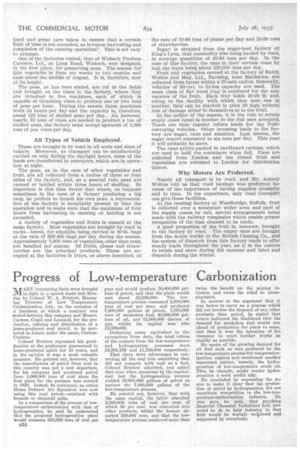Progress of Low-temperature Carbonization l iTANY interesting facts were brought V_Lto
Page 52

If you've noticed an error in this article please click here to report it so we can fix it.
light in a speech made last Monday by Colonel W. A. Bristow, Managing Director of Low Temperature Carbonisation, Ltd., on the occasion of a luncheon at which a contract was pealed between this company and Messrs. Carless, Cape]. and Leonard, for the production, refining and distribution of a home-produced coal petrol, to be marketed in future under the name, CarlessCoalene.
Colonel Bristow expressed, his gratification at the preference guaranteed to home-produced spirit for 10 years, and in his opinion it was a most valuable measure. He pointed out, however, that the manufacture of petrol from coal in this country was not a new departure, for his company had produced petrol from 1,000,000 tons of coal since the first plant for the purpose was erected in 1928. Indeed, he continued, an entire Home Defence Air Squadron was now using this coal petrol—unmixed with lienzole or chemical salts.
. In a comparison of the process of lowtemperature carbonization with that of hydrogenation, he said he understood that the proposed hydrogenation plant would consume 350,000 tons of coal per B34 year and would produce 30,000,000 gallons of petrol, and that the plant would cost about £2,500,000. The lowtemperature process consumed 2,500,000 tons of coal per year, and produced 7,000,000 gallons of petrol, 1,750,000 tons of smokeless fuel, 40,000,000 gallons of oil, and 75,000,000 therms of gas, whilst its capital was also £2,5001000.
Deducting sums, equivalent to the exemptions from duty, the total values of the outputs from the low-temperature and hydrogenation processes were £4,304,166 and £1,750,000 respectively.
That there were advantages in converting all the coal into something that did not compete with coal as a fuel, Colonel Bristow admitted, and added that even when measured by the capitalcost test the hydrogenation process yielded 30,000.000 gallons of petrol as against the 7,000,000 gallons of the low-temperature process.
He pointed out, however, that with the same capital, the latter absorbed 2,500,000 tons of coal per year of which 30 per cent, was converted into other products, whilst the former absorbed 350,000 tons, and that the lowtemperature process conferred more than twice the benefit on the mining industry, and twice the relief to unemployment.
In answer to the argument that it was better to carry on a process which did not involve the disposal of any other products than petrol, he stated that events indicated the likelihood that the demand for smokeless fuel would run ahead of production for years to come, and that it was the intention of his company to erect further woyks as rapidly as possible.
He spoke of the growing demand for oil fuel such as was produced by the low-temperature process for compressionignition engines and mentioned another important matter, namely, the hydrogenation of low-temperature crude oil. This, he thought, might render hydrogenation a most useful ally.
He concluded by expressing the desire to make it clear that the production of petrol by hydrogenation did not constitute competition to the low-temperature-carbonization industry. He was sure, he said, that anything Imperial Chemical Industries Ltd. prerposed to do to help industry in that field would be warmly welfomed and supported by everybody.




































































































